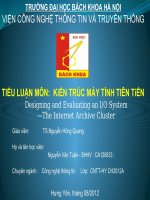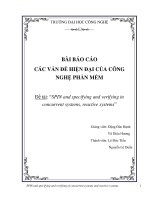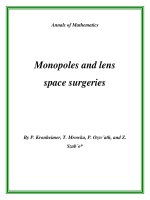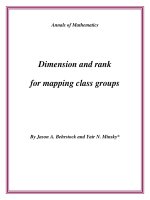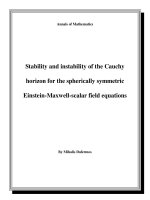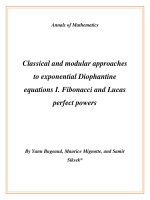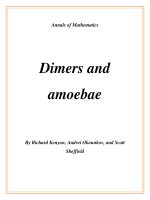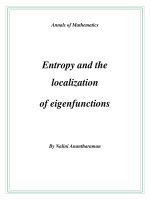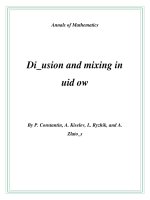ĐỀ TÀI " Historical and Future Trends in Aircraft Performance, Cost, and Emissions " pptx
Bạn đang xem bản rút gọn của tài liệu. Xem và tải ngay bản đầy đủ của tài liệu tại đây (962.79 KB, 160 trang )
Historical and Future Trends in Aircraft Performance, Cost, and Emissions
by
Joosung Joseph Lee
B.S., Mechanical Engineering
University of Illinois at Urbana-Champaign, 1998
Submitted to the Department of Aeronautics and Astronautics and
the Engineering Systems Division
in Partial Fulfillment of the Requirements for the Degrees of
Master of Science in Aeronautics and Astronautics
and
Master of Science in Technology and Policy
at the
Massachusetts Institute of Technology
September 2000
2000 Massachusetts Institute of Technology
All rights reserved
Signature of Author…………………………………………………………………………………………………….
Department of Aeronautics and Astronautics and
Technology and Policy Program
August 4, 2000
Certified by…………………………………………………………………………………………………………….
Ian A. Waitz
Associate Professor of Aeronautics and Astronautics
Thesis Supervisor
Accepted by……………………………………………………………………………………………………………
Nesbitt W. Hagood
Associate Professor of Aeronautics and Astronautics
Chairman, Department Graduate Committee
Accepted by……………………………………………………………………………………………………………
Daniel E. Hastings
Professor of Engineering Systems and Aeronautics and Astronautics
Director, Technology and Policy Program
2
3
Historical and Future Trends in Aircraft Performance, Cost, and Emissions
by
Joosung Joseph Lee
Submitted to the Department of Aeronautics and Astronautics and
the Engineering Systems Division on August 4, 2000
in Partial Fulfillment of the Requirements for the Degrees of
Master of Science in Aeronautics and Astronautics and
Master of Science in Technology and Policy
Abstract
Air travel is continuing to experience the fastest growth among all modes of transport. Increasing total
fuel consumption and the potential impacts of aircraft engine emissions on the global atmosphere have
motivated the industry, scientific community, and international governments to seek various emissions
reduction options. Despite the efforts to understand and mitigate the impacts of aviation emissions, it still
remains uncertain whether proposed emissions reduction options are technologically and financially
feasible.
This thesis is the first of its kind to analyze the relationship between aircraft performance and
cost, and assess aviation emissions reduction potential based on analytical and statistical models
founded on a database of historical data. Technological and operational influences on aircraft
fuel efficiency were first quantified utilizing the Breguet range equation. An aviation system
efficiency parameter was defined, which accounts for fuel efficiency and load factor. This
parameter was then correlated with direct operating cost through multivariable statistical
analysis. Finally, the influence of direct operating cost on aircraft price was statistically
determined.
By comparing extrapolations of historical trends in aircraft technology and operations with future
projections in the open literature, the fuel burn reduction potential for future aircraft systems was
estimated. The economic characteristics of future aircraft systems were then determined by
utilizing the technology-cost relationship developed in the thesis. Although overall system
efficiency is expected to improve at a rate of 1.7% per year, it is not sufficient to counter the
projected annual 4 to 6% growth in demand for air transport. Therefore, the impacts of aviation
emissions on the global atmosphere are expected to continue to grow. Various policy options for
aviation emissions reduction and their potential effectiveness are also discussed.
Thesis Supervisor: Ian A. Waitz
Title: Associate Professor of Aeronautics and Astronautics
4
5
Acknowledgements
I cannot express enough gratitude to the great advisor, Prof. Ian Waitz. His intellectual
superiority and friendly care for students have been an invaluable learning experience for me. I
also deeply thank Steve Lukachko, a wonderful colleague with a positive, enthusiastic mind, Dr.
Andreas Schafer, and Raffi Babikian for their sincere help and friendship.
This work was carried out by internal financial supports from the MIT Cooperative
Mobility Program and Center for Environmental Initiative (CEI). I would like to cordially thank
Prof. Daniel Roos and Prof. David Marks for all their physical and mental supports.
NASA has provided a great amount of aircraft data for this work. I am deeply thankful to
Bill Haller at Glenn Research Center, who helped so much in the midst of his busy schedule, Mr.
Tom Galloway and Mr. Shahab Hasan at NASA Ames Research Center for allowing me to use
ACSYNT, and all other NASA staff including Paul Gelhausen who helped with putting the
aircraft databases together. I am also grateful to the faculty members and students at MIT
International Center for Air Transportation (ICAT). Prof. Peter Belobaba, Prof. John-Paul Clark,
Alex Lee, and Bruno Miller provided valuable inputs. I also would like to thank Dr. David
Greene at Oak Ridge National Laboratory for sharing his previous work and all other industry
representatives for their feedback for the project. I am also thankful to the staff members at the
US Department of Transportation. Mr. Jeff Gorham helped greatly with data acquisition and
clarification. I thank all others who helped with every other aspect of this project.
I also would like to deeply thank all GTL faculty and staff members. It is a terrific
experience to study around the world-renowned professors and researchers at GTL. All GTL
students are also a great group of people to work with. I am particularly thankful to the students
in Prof. Waitz’s group.
I give many, many thanks to my family, church members, friends, and relatives for their
prayers. My father, mother, brother, sister-in-law, sister, and brother-in-law are my great
supporters. It is all by the grace of God that I am who I am. May all glory be to Him.
6
7
Contents
Abstract
Acknowledgment
List of Figures
List of Tables
Nomenclature
Glossary
1 Introduction 19
1.1 Background ……………………………………………………………………… 19
1.2 Goals and Objectives ……………………………………………………………… 21
1.3 Methodology ……………………………………………………………………….21
1.4 Organization of the Thesis …………………………………………………………22
2 Aviation Growth and Impacts on the Global Atmosphere 25
2.1 Introduction ……………………………………………………………………… 25
2.2 Aviation and the Environment Today …………………………………………… 25
2.3 Aviation Growth and Future Emissions ……………………………………………28
2.4 Policy Responses ………………………………………………………………… 30
2.5 Chapter Summary …………………………………………………………………. 31
3 Historical Trends in Aircraft Performance and Cost 37
3.1 Introduction ……………………………………………………………………… 37
3.2 Databases ………………………………………………………………………… 37
3.3 Fleet Selection and Categorization ……………………………………………… 39
3.4 Historical Trends in Aircraft Performance and Cost ……………………………… 40
3.4.1 Aircraft Performance ……………………………………………………… 40
3.4.1.1 Fuel consumption ………………………………………………… 40
3.4.1.2 Engines …………………………………………………………… 40
3.4.1.3 Aerodynamics …………………………………………………… 41
3.4.1.4 Structures ………………………………………………………… 41
8
3.4.1.5 Operational factors …………………………………………………42
3.4.1.6 Fleet fuel consumption …………………………………………… 42
3.4.2 Aircraft Cost ……………………………………………………………… 43
3.4.2.1 Direct operating cost and investment ………………………………43
3.4.2.2 Direct operating cost ……………………………………………….44
3.4.2.3 Price ……………………………………………………………… 45
3.5 Chapter Summary …………………………………………………………………. 46
4 Parametric Modeling of Technology-Operability-Fuel Economy Relationships 61
4.1 Introduction ……………………………………………………………………… 61
4.2 The Breguet Range Equation …………………………………………………… 61
4.2.1 Theory …………………………………………………………………… 61
4.2.2 Range Calculation and Correction …………………………………………62
4.3 Taylor Series Expansion ………………………………………………………… 66
4.3.1 Theory …………………………………………………………………… 66
4.3.2 1
st
Order Taylor Series Expansion of the Breguet Range Equation ……… 67
4.3.3 1
st
Order Taylor Series Expansion of the Fuel Consumption Equation ……68
4.4 Chapter Summary …………………………………………………………………. 70
5 Parametric Modeling of Technology-Cost Relationship 77
5.1 Introduction ……………………………………………………………………… 77
5.2 Aircraft System Performance and Cost …………………………………………….77
5.2.1 Parameter Development ……………………………………………………77
5.2.1.1 Fuel consumption and direct operating cost and price …………… 78
5.2.1.2 Aircraft usage and size and direct operating cost …………………. 79
5.2.2 Aviation System Efficiency and Direct Operating Cost ………………… 79
5.2.3 Direct Operating Cost and Price ………………………………………… 81
5.3 Technology-Cost Relationship and Application ………………………………… 83
5.4 Uncertainty Analysis ……………………………………………………………….84
5.4.1 Error Propagation ………………………………………………………… 84
5.4.2 Sources of Uncertainty …………………………………………………… 88
9
5.5 Chapter Summary …………………………………………………………………. 89
6 Future Trends in Aircraft Performance, Cost, and Emissions 101
6.1 Introduction ……………………………………………………………………… 101
6.2 Comparison of Study Methods ……………………………………………………. 101
6.3 Future Trends in Aircraft Performance …………………………………………….103
6.3.1 Technology ……………………………………………………………… 103
6.3.1.1 Engines …………………………………………………………… 103
6.3.1.2 Aerodynamics …………………………………………………… 105
6.3.1.3 Structures ………………………………………………………… 106
6.3.2 Operability ………………………………………………………………… 107
6.3.2.1 Air traffic management …………………………………………….107
6.3.2.2 Load factor …………………………………………………………108
6.3.3 Fuel Consumption ………………………………………………………….109
6.3.3.1 Projections based on historical trends …………………………… 109
6.3.3.2 Other projections ………………………………………………… 109
6.4 Future Trends in Aircraft Cost …………………………………………………… 111
6.4.1 Direct Operating Cost and Price ………………………………………… 112
6.4.2 Impact of External Factors on Aircraft Cost ……………………………….113
6.5 Future Trends in Aviation Fuel Use and Emissions ………………………………. 114
6.5.1 Fleet Evolution …………………………………………………………… 114
6.5.2 Technology Uptake ….…………………………………………………… 115
6.5.3 Aviation Fuel Consumption and Emissions ……………………………… 115
6.5.3.1 Emissions forecasts ……………………………………………… 115
6.5.3.2 Emissions reduction and limiting factors ………………………… 116
6.5.3.3 Alternatives to emissions reduction ……………………………… 117
6.6 Chapter Summary …………………………………………………………………. 118
7 Aviation Emissions and Policy Perspective 129
7.1 Introduction ……………………………………………………………………… 129
7.2 Aviation Emissions Policy …………………………………………………………129
10
7.2.1 Goals ………………………………………………………………………. 129
7.2.2 Policy Options for Emissions Reduction ………………………………… 130
7.2.2.1 Engine certification ……………………………………………… 130
7.2.2.2 Environmental levies ……………………………………………… 130
7.2.2.3 Emissions trading ………………………………………………… 131
7.2.2.4 Alternative transport modes ……………………………………… 132
7.3 Aviation Sector's Emissions Reduction Burden ………………………………… 132
7.4 Chapter Summary …………………………………………………………………. 134
8 Summary and Conclusions 137
References 141
Appendix 145
A.1 SFC Calibration Procedure …………………………………………………………… 145
A.2 Engine/Planform Configurations for Selected Aircraft Types ……………………… 149
A.3 Form 41 P52 Financial Database for Direct Operating Cost …………………………. 151
A.4 GDP Deflators Used ………………………………………………………………… 153
A.5 Fuel Reserve Requirements ………………………………………………………… 155
A.6 Minimum Flight Hours Calculation ………………………………………………… 157
A.7 Jet Fuel Prices Used ………………………………………………………………… 159
11
List of Figures
Figure 2.1: Radiative Forcing Due to Aircraft Emissions in 1992 (Source: IPCC, 1999 .…32
Figure 2.2a: Global Contrail Coverage in 1992 (Source: IPCC, 1999) ………………… 33
Figure 2.2b: Global Contrail Coverage in 2050 (Source: IPCC, 1999) ……………………33
Figure 2.3: Modal Traffic Demand Forecast (Source: Schafer, 1998b) ………………… 34
Figure 2.4: Various Air Traffic Growth Forecasts …………………………………………34
Figure 2.5: NASA Global CO
2
Emissions Reduction Scenarios (Source: Rohde, 1999) ….35
Figure 2.6: Radiative Forcing Due to Aircraft Emissions in 2050 (Source: IPCC, 1999) 35
Figure 3.1: Comparison of RPMs Performed by 31 Aircraft Types Operated by 10 Major U.S.
Passenger Airlines and RPMs Performed by All Aircraft Types Operated by All U.S.
Passenger Airlines …………………………………………………………… 49
Figure 3.2: Historical Trends in Fuel Burn for Short-range Aircraft ………………………50
Figure 3.3: Historical Trends in Fuel Burn for Long-range Aircraft ………………………50
Figure 3.4: Historical Trends in Engine Efficiency ……………………………………… 51
Figure 3.5: Historical Trends in Aerodynamic Efficiency …………………………………51
Figure 3.6: Historical Trends in Structural Efficiency …………………………………… 52
Figure 3.7: Historical Trends in Fuel Burn and Load Factor for B-747-400 ………………53
Figure 3.8: Historical Trends in Fuel Burn and Seats for B-747-400 …………………… 53
Figure 3.9: Historical Trends in U.S. Fleet Fuel Consumption and Technology Uptake ….54
Figure 3.10: Typical DOC+I Composition ……………………………………………… 55
Figure 3.11: Historical Trends in DOC+I ………………………………………………….55
Figure 3.12: Historical Trends in DOC without Fuel Cost for Short-range Aircraft ………56
Figure 3.13: Historical Trends in DOC without Fuel Cost for Long-range Aircraft ………56
Figure 3.14: Historical Trends in Short-range Aircraft Prices …………………………… 57
Figure 3.15: Historical Trends in Long-range Aircraft Prices …………………………… 57
Figure 3.16: Price versus Year of Introduction for Short-range Aircraft …………………. 58
Figure 3.17: Price versus Year of Introduction for Long-range Aircraft .………………….58
Figure 3.18: Parametric Modeling Framework for Aircraft Performance and Cost ……….59
Figure 4.1: Calculated Range versus Actual Stage Length Flown ……………………… 71
Figure 4.2: Deviation of Calculated Stage Length versus Actual Stage Length Flown … 71
12
Figure 4.3: Various Ratios of Aircraft Operating Hours ………………………………… 72
Figure 4.4: Range Calculation Corrected by Minimum Flight Hours to Block Hours
Ratio ………………………………………………………………………… 72
Figure 4.5: Deviation of Calculated Stage Length versus Calculated Stage Length ………73
Figure 4.6: Stage Length Calculated by Taylor Series versus Original Function of Breguet Range
Equation ……………………………………………………………………… 74
Figure 4.7: Percent Improvement in Range Due to 1% Improvement in Performance and
Operability …………………………………………………………………… 75
Figure 4.8: Percent Reduction in Fuel Consumption Due to 1% Improvement in Performance and
Operability …………………………………………………………………… 76
Figure 5.1: Direct Operating Cost versus Fuel Consumption …………………………… 95
Figure 5.2: Direct Operating Cost versus Fuel Consumption …………………………… 95
Figure 5.3: Direct Operating Cost versus Revenue Passenger Miles …………………… 96
Figure 5.4: Direct Operating Cost versus Block Hours ……………………………………96
Figure 5.5: Direct Operating Cost versus Aviation System Efficiency ……………………97
Figure 5.6: Crossvalidation of DOC Model ……………………………………………… 97
Figure 5.7: Aircraft Price versus Direct Operating Cost ………………………………… 98
Figure 5.8: Calculated Fuel Efficiency versus Actual Fuel Efficiency …………………… 99
Figure 6.1: Future Trends in Specific Fuel Consumption ………………………………….123
Figure 6.2: Historical Trends in Ground, Airborne, and Total Flight Time Efficiencies ….124
Figure 6.3: Historical and Future Trends in Load Factor …………………………………. 124
Figure 6.4: Various Fuel Burn Reduction Projections …………………………………… 125
Figure 6.5: Major Contributors for Aircraft Fuel Burn Reduction in the Past and Future 125
Figure 6.6: Projected Direct Operating Costs for Future Aircraft ………………………… 126
Figure 6.7: Projected Prices for Future Aircraft ………………………………………… 126
Figure 6.8: Impact of Fuel Price on Direct Operating Cost ……………………………… 127
Figure 6.9: Various CO
2
Emissions Growth Forecasts …………………………………….128
Figure 7.1: Impacts of European Emission Charges ……………………………………….136
Figure A1.1: ICAO Take-off SFC versus Jane's Take-off SFC ………………………… 145
Figure A1.2: Jane's Cruise SFC versus ICAO Take-off SFC …………………………… 146
Figure A7.1: Jet Fuel Prices versus Crude Oil Prices during 1980-98 …………………….160
13
List of Tables
Table 3.1: Configurations and Typical Operations for 31 Aircraft Types …………………47
Table 5.1: DOC Categories Used in Parametric Study ……………………………….……90
Table 5.2: Summary Statistics for DOC Regression ……………………………………… 91
Table 5.3: Summary Statistics for Price Regression ……………………………………….92
Table 5.4: Impacts of Technological Changes on Fuel Efficiency, DOC, and Price of
B-777 ……………………………………………………………………………93
Table 5.5: Summary Results for Propagated Error of Technology-Cost Relationship …….94
Table 6.1: Various Fuel Burn Reduction Projections …………………………………… 120
Table 6.2: Direct Operating Cost and Price Projections for Future Aircraft ……………… 121
Table 6.3: Total Aviation Fuel Consumption, CO
2
Emissions, and Associated Economic
Characteristics in 2025 and 2050 ………………………………………………. 122
Table 7.1: Fuel Efficiency Improvement Required to Meet Kyoto Protocol and Resulting
Economic Characteristics ……………………………………………………….135
14
15
Nomenclature
Roman
FC Fuel consumption
FE Fuel efficiency
g Gravity constant
SL Stage length
V Velocity
WWeight
Greek
α Load factor
δ
correction
Correction factor for deviation in the calculation of the Breguet range
equation
η
aviation system
Aviation system efficiency
η
energy
Aircraft energy efficiency in available seat miles per gallon of fuel burn
η
load factor
Load factor expressed as efficiency of utilizing aircraft seats
σ
2
Variance
Subscripts
f Fuel
i Individual passenger
pPayload
r Reserve, fuel
s Structure, aircraft
16
17
Glossary
ADL Arthur D. Little
AERO The Dutch Aviation Emissions and Evaluation of Reduction Options
Airborne Hours Time duration for which aircraft stays in the air
ASE Aviation system efficiency
ASM Available seat miles
ATM Air traffic management, or available ton miles
Block Hours Time duration for which aircraft leaves away from the gate when blocks
are removed from the wheels
Block Speed Average speed of aircraft for a trip based on block hours (Stage
Length/Block Hours)
CAEP Committee on Aviation Environmental Protection
CO Carbon monoxide
CO
2
Carbon dioxide
DLR The Deutsches Zentrum für Luft- and Raumfahrt
DOC Direct operating cost
DOC+I Direct operating cost plus investment
DTI Department of Trade and Industry
ECoA Environmental Compatibility Assessment
EDF Environmental Defense Fund
ETSU The Energy Technology Support Unit
FESG Forecasting and Economic Support Group
gal Gallons of jet fuel
GDP Gross domestic product
GHG Greenhouse gas
GNP Gross national product
H
2
O Water vapor
HC Hydrocarbons
HSCT High-speed civil transport
ICAO International Civil Aviation Organization
18
IPCC Intergovernmental Panel on Climate Change
L/D Lift-to-drag ratio
LEBU Large-eddy break up devices
LFC Laminar flow control
Load Factor Percentage of seats filled by passengers (RPM/ASM)
LTO Landing and takeoff
Minimum Hours Minimum time duration for a trip
MPH Miles per hour
MTOW Maximum takeoff weight
NRC National Research Council
NO
x
Nitrogen oxides
OEW Operating empty weight
OEW/MTOW Operating empty weight-to-maximum takeoff weight ratio
Payload Weight of passengers and cargo carried on board
RPM Revenue passenger miles
SFC Specific fuel consumption
SO
x
Sulfur oxides
Stage Length Aircraft distance flown for a trip between airports
TAM Total aircraft miles
UHB Unducted ultra-high-bypass ratio engines
UNFCCC UN Framework Convention on Climate Change
USDOT U.S. Department of Transportation
UV-B Ultraviolet-B
VLA Very large aircraft
WWF World Wildlife Fund
19
Chapter 1
Introduction
1.1 Background
Air travel is continuing to experience the fastest growth among all modes of transport, averaging
5 to 6% per year. Increasing total aviation emissions from aircraft engines and their potential
impacts on the global atmosphere have drawn the attention of the aviation industry, the scientific
community, and international governments. Aircraft engines emit a wide range of greenhouse
gases (GHGs) including carbon dioxide (CO
2
), water vapor (H
2
O), nitrogen oxides (NO
x
),
hydrocarbons (HC), carbon monoxide (CO), sulfur oxides (SO
x
), and particulates. The radiative
forcing from these aircraft emissions discharged directly at altitude is estimated to be 2 to 4 times
higher than that due to aircraft carbon dioxide emissions alone, whereas the overall radiative
forcing from the sum of all anthropogenic activities is estimated to be a factor of 1.5 times that of
carbon dioxide emissions at the ground level (IPCC, 1999).
If the strong growth in air travel continues, world air traffic volume may increase five-fold
to as much as twenty-fold by 2050 compared to the 1990 level and account for roughly two-
thirds of global passenger-miles traveled (IPCC, 1999; Schafer and Victor, 1997). Global
modeling estimates directed by the Intergovernmental Panel on Climate Change (IPCC) show
that aircraft were responsible for about 3.5% of the total accumulated anthropogenic radiative
forcing of the atmosphere in 1992, and their radiative forcing may increase to 5.0% of the total
anthropogenic forcing with a 1σ uncertainty range of 2.7% to 12.2% by 2050 (IPCC, 1999).
Given the strong growth in air travel and increasing concerns associated with the effects of
aviation emissions on the global atmosphere, the aviation industry is likely to face a significant
environmental challenge in the near future (Aylesworth, 1996). Current estimates show that
global air traffic volume is growing so fast that total aviation fuel consumption and subsequent
aviation emissions’ impacts on climate change will continue to grow despite future
improvements in engine and airframe technologies and aircraft operations (IPCC, 1999; Greene,
20
1995). This implies that current technological and operational improvements alone may not fully
offset the increasing aviation emissions while the aviation sector sees an impetus to find
alternatives to mitigate the potential effects of aviation emissions on the global atmosphere.
In response to this, a global dialog has arisen to address the growing environmental
concerns of aviation. The United Nations (UN) gave the International Civil Aviation
Organization (ICAO) the authority to monitor aviation industry’s emissions reduction efforts and
seek further options to mitigate the impacts of aviation emissions on local air quality and the
global atmosphere through its Committee on Aviation Environmental Protection (CAEP). In a
broader perspective of climate change, the Kyoto Protocol to the UN Framework Convention on
Climate Change (UNFCCC), which was adopted in December 1997, was the first international
initiative to include two provisions that were particularly relevant to aviation emissions.
Despite these various efforts to understand and mitigate aviation’s emissions impacts, it still
remains uncertain which emissions abatement options are feasible ones under the various
constraints of the aviation sector. Most importantly, it is not clear whether proposed emissions
abatement options are financially feasible for the aviation sector. Air transport requires higher
capital and operating costs than other modes of transport do while its typical profit margin is
only 5% (NRC, 1992). Thus, economic feasibility may be one of the most important limiting
factors in aviation emissions abatement efforts.
In this regard, insights into future aviation emissions mitigation require the simultaneous
understanding of the relationship between technological improvements and their associated
economic characteristics as accepted by the aviation sector in the past. However, very little
system-level understanding of feasible aviation emissions abatement technologies and costs
exists at present. Hence, this thesis is the first of its kind to analyze the relationship between
aircraft performance and cost, and assess aviation emissions reduction potential based on
analytical and statistical models founded on a database of historical data.
21
1.2 Goals and Objectives
The primary goal of this thesis is to quantitatively understand technological and operational
influences on aircraft performance as measured by environmental metrics relevant to aviation’s
impacts on climate change and relate the performance metrics to aircraft cost in order to
determine the technological and economic feasibility of aviation emissions reduction potential in
the future.
In order to accomplish the primary goal, two analysis objectives are identified as follows:
(A) To understand historical trends in aircraft performance and cost and establish a quantitative
relationship between them.
(B) To project the technological and economic characteristics of future aircraft systems and
assess total emissions reduction potential for the aviation sector.
1.3 Methodology
The analysis approach of this thesis consists of two phases. In the first phase, a comprehensive
technology-cost relationship is determined by analyzing historical data for aircraft engine,
aerodynamic, and structural technologies as well as aircraft direct operating cost (DOC) and
prices. The flying range of aircraft systems, as determined by technologies and operational
conditions, is analytically understood by utilizing the Breguet range equation and contrasted to
that observed in actual aircraft operations data. By further employing the Breguet range equation,
aircraft fuel consumption measured in fuel burn per revenue passenger-mile (RPM) is modeled
based on technology and operability parameters. A multivariable statistical analysis is then
employed to establish a quantitative relationship between aviation system efficiency (ASE),
which is defined to capture improvements in aircraft technology and operations, and DOC.
Lastly, the relationship between DOC and aircraft prices is also statistically analyzed.
In the second phase, projections are made for the technological and economic
characteristics of future aircraft systems. As for technological and operational improvements,
extrapolations of historical trends and resulting fuel efficiency improvement are compared with
the projections made by National Aeronautics and Space Administration (NASA) and other
22
major studies in the open literature. The technology-cost relationship obtained in the first phase
is then utilized to determine the potential DOC and price impacts of future aircraft systems. Once
fuel efficiency improvement potential and resulting costs for future aircraft systems are
projected, the feasibility of total aviation emissions reduction is examined. In addition, various
policy measures to further mitigate aviation emissions growth are discussed.
1.4 Organization of the Thesis
Chapter 2 reviews the current status of aviation’s impacts on the global atmosphere. Various
aircraft emissions and their global warming potential are discussed in light of strong air traffic
growth. Policy responses to address increasing concerns associated with aviation emissions are
also discussed.
Chapter 3 examines historical trends in aircraft performance and cost. It first describes the
data used and then discusses historical trends and drivers in aircraft fuel consumption, DOC, and
prices.
Chapter 4 contains a parametric modeling of technology-operability-fuel consumption
relationships. The impacts of technology and operability on aircraft fuel consumption are
analytically quantified based on the Breguet range equation.
Chapter 5 describes the parametric modeling of a technology-cost relationship. By means
of statistical analyses, the relationship between aircraft technology, DOC, and prices are
quantified.
Chapter 6 examines future trends in aircraft performance, cost, and emissions. Aircraft fuel
consumption reduction potential based on technological and operational improvements is
discussed. The DOC and prices of future aircraft systems are also projected and discussed.
Lastly, an outlook for future aviation emissions trends is discussed in light of expected
improvements in aircraft fuel efficiency, air traffic growth, and various constraints in aviation
systems.
23
Chapter 7 is a discussion of various policy options to further address growing aviation
emissions. As an example of a market-based policy option, the impacts of a fuel tax on airline
costs are examined based on an application of the technology-cost relationship developed in this
thesis.
Chapter 8 summarizes the important findings of this thesis and draws conclusions relative
to historical and future trends in aircraft performance, cost, and emissions.
All figures and tables are shown at the end of each chapter while all appendices are shown
at the end of the thesis.

